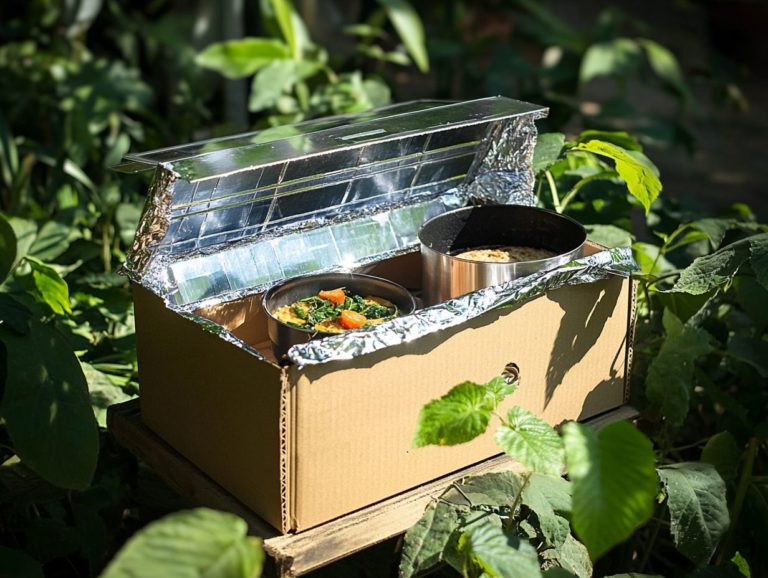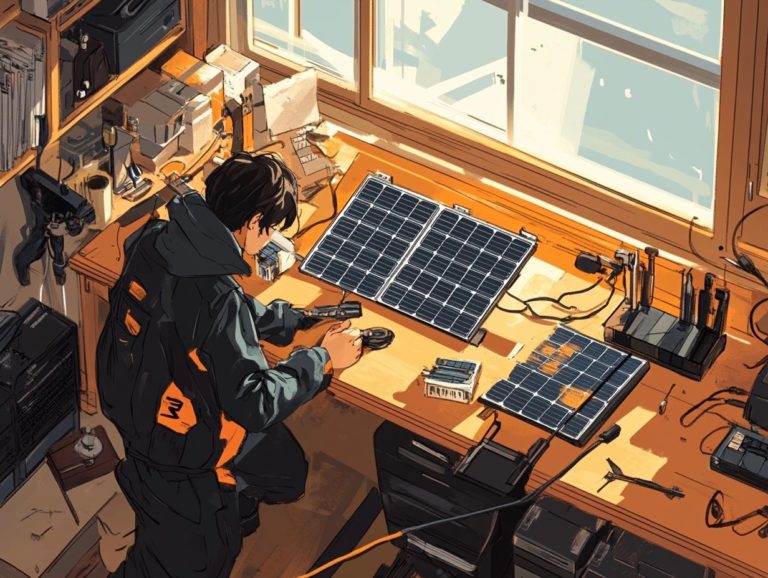Step-by-Step Guide to Building a DIY Solar Tracker
Want to boost your solar energy production? Try creating a DIY solar tracker with a PA-14 Mini Linear Actuator!
A solar tracker automatically adjusts your solar panels to follow the sun. This greatly improves efficiency and reduces your energy costs. This guide covers everything you need to know, including the benefits of crafting your own tracker, the necessary materials, and comprehensive step-by-step instructions for assembly. You’ll also find essential maintenance tips.
Prepare to harness the power of the sun like never before!
Contents
- Key Takeaways:
- Benefits of Building a DIY Solar Tracker
- Materials and Tools Needed
- Step-by-Step Instructions
- Tips for Maintenance and Troubleshooting
- Frequently Asked Questions
- Ready to build your DIY solar tracker? Here s what you ll need!
- What is the purpose of a solar tracker?
- Do I need any technical experience to build a DIY solar tracker?
- How long does it take to build a DIY solar tracker?
- Do I need to calibrate the solar tracker after building it?
- Can I customize my DIY solar tracker design?
Key Takeaways:
- Save money and boost efficiency with a DIY solar tracker. Use affordable materials to get the most energy from your setup.
- Gather materials such as wooden planks, screws, motors like the Wasp Motor Controller, and solar panels. Follow step-by-step instructions to build your own solar tracker.
- Keep your solar tracker in top shape by checking for wear and tear. Cleaning and troubleshooting will help maintain optimal performance. Monitor the photoresistor readings to ensure accurate tracking of the sun.
What is a Solar Tracker and How Does it Work?
A solar tracker is a remarkable device designed to boost the efficiency of your solar panels by adjusting their orientation to follow the sun s journey across the sky each day. With the aid of advanced technologies like light sensors and photoresistors, a solar tracker optimizes the tilt angle of your solar power systems that convert sunlight into electricity, ensuring that your solar panels capture the maximum amount of sunlight available. This system uses Direct Current electricity to power the adjustments made by the linear actuators.
This mechanism boosts energy efficiency and maximizes renewable energy generation, making it essential in solar energy today. The use of solar power systems highlights its importance in generating electrical energy from the sun.
Solar trackers come in two main styles: single-axis and dual-axis systems. Single-axis trackers rotate on a single axis, tilting either horizontally or vertically. They can notably increase your energy output by following the sun’s path from east to west. On the other hand, dual-axis trackers provide even greater precision by adjusting both vertically and horizontally, allowing them to capture sunlight at varying angles throughout the day and across seasons. These systems often include an electric motor for precise movement control.
Arduino Microcontrollers are integral to automating these systems, facilitating real-time adjustments based on sensor feedback. By effectively utilizing solar trackers, you can significantly enhance the overall energy production of your solar installations, making them a smart investment in your journey toward sustainable energy practices.
Benefits of Building a DIY Solar Tracker
Building your own solar tracker offers amazing benefits, from substantial cost savings to enhanced energy efficiency. You can harness solar energy with greater effectiveness.
Using easily accessible components like 12v linear actuators and a solar charge controller such as the Genasun GV-10, you can craft a portable solar tracker that significantly boosts the output of your solar panels.
This hands-on project not only champions the use of renewable energy but also cultivates a richer understanding of solar technologies and their environmental impact.
Don t miss out on the chance to innovate and play your part in a more sustainable future.
Cost Savings and Increased Efficiency
Implementing a solar tracker can lead to substantial cost savings and enhanced efficiency in your solar energy system. This enables you to maximize your return on investment. By actively adjusting the angle of your solar panels, a solar tracker ensures optimal exposure to sunlight. This often results in a remarkable boost in energy output improving efficiency by 25% or more compared to fixed installations.
Utilizing high-quality components like the Genasun GV-10 solar charge controller can further elevate this efficiency, making it a savvy choice for anyone interested in renewable energy.
You ll quickly see a real drop in your energy costs, as solar trackers generate more electricity throughout the day, effectively lowering your utility bills. Regarding calculating your return on investment, many users discover that the initial expenses associated with solar trackers can be recouped within just a few years thanks to these savings. The extra energy produced not only brings economic benefits but also promotes a sustainable lifestyle amid the ongoing challenges of climate change.
By adopting this advanced technology, you contribute to a significant reduction in reliance on fossil fuels. This paves the way for a cleaner, more eco-friendly future while reaping the financial rewards of increased energy independence.
Materials and Tools Needed
When you embark on the journey to build your own DIY solar tracker, gathering the right materials and tools becomes paramount for your success. Key components you ll need include a solar panel like the Sungold SGM-90W-18V, which will efficiently harness solar energy; the PA-14 Mini Linear Actuator, perfect for precise adjustments; an Arduino to automate the system; and photoresistors that will measure sunlight levels. Consider incorporating pulse width modulation for more refined control of your linear actuators. This method helps control the speed and movement of the actuators more smoothly.
Having a lithium-ion battery, such as a 12VDC Lithium-Ion Battery, and other essential tools in your arsenal will ensure you establish a reliable solar tracking system, setting the stage for a successful renewable energy project.
Gathering the Necessary Components
To construct an efficient solar tracker, you ll need to gather several crucial components that work in harmony to ensure optimal performance. Start with the Arduino microcontroller for programming, linear actuators for movement, and a photoresistor to detect sunlight intensity. A reliable solar charge controller, like the Genasun GV-10, paired with a 12VDC lithium-ion battery, is essential for maintaining energy storage and providing power to the system.
Each part plays a critical role in making your solar tracker work efficiently. The Arduino serves as the brain of the system, enabling precise control and allowing you to adjust algorithms for improved tracking. Linear actuators are critical for moving the solar panels smoothly and accurately toward the sun, minimizing mechanical wear and ensuring longevity. The photoresistor acts as an essential sensor, enabling the system to dynamically adjust based on real-time sunlight conditions. Using an electric motor in conjunction with the Wasp Motor Controller can enhance the accuracy of your solar tracker s movements.
When selecting a solar charge controller, it s crucial to ensure compatibility with your battery type to avoid potential issues like overcharging or inefficiency. Regularly check connections and calibrate the sensors to troubleshoot common problems that may arise during operation. Choosing high-quality components not only enhances reliability but also maximizes the overall efficiency of your solar energy harnessing system. Proper integration of components like the Genasun GV-10 can ensure optimal performance and longevity of your solar tracker.
Start your solar tracking project today for a brighter, eco-friendly future!
Step-by-Step Instructions
Constructing a solar tracker can be an exhilarating and fulfilling endeavor. Adhering to detailed step-by-step instructions paves the way for a successful result. Begin by building a sturdy base and frame designed to support the weight of the solar panels while enduring various environmental conditions often associated with diverse habitats. Once that foundation is established, you ll move on to installing the solar panels and integrating the tracking mechanism, ultimately breathing life into your solar tracking system and optimizing energy efficiency in the process.
Building the Base and Frame
The foundation of your DIY solar tracker begins with constructing a sturdy base and frame, which is crucial for ensuring the stability and longevity of your system. You need to design the base to withstand wind and other factors while adequately supporting the solar panels that will be mounted on it. By selecting durable materials and adhering to careful building methods, you set the stage for maximizing energy efficiency and optimal performance in your solar tracking system.
Consider using reinforced concrete or treated lumber that can resist deterioration, ensuring your structure stands the test of time. Proper weight distribution is essential; design the frame to evenly balance the solar panel loads, preventing any undue stress. For added weather resistance, incorporating protective coatings or sealants can safeguard against moisture damage. Ensuring the structure can withstand wind forces is also critical for stability.
Achieving correct alignment during construction is vital for the tracker to function efficiently, allowing it to follow the sun s path accurately. Ensuring an optimal tilt is also crucial for maximizing energy capture. Paying attention to these details will dramatically influence the overall effectiveness of your solar tracking system.
Installing the Solar Panels
Installing solar panels correctly on your DIY solar tracker is crucial for achieving optimal energy efficiency. When you ensure proper alignment, your panels can tilt effectively to follow the sun s path throughout the day, maximizing solar energy capture. Securely mounting the panels will set you up for success! Make all necessary connections to create a reliable and efficient solar tracking system. Incorporating robotics elements can automate adjustments and enhance the system’s overall performance.
In addition to secure mounting, selecting the right materials is essential to withstand environmental factors, preventing future maintenance headaches. Safety should be a top priority. Use proper gear, such as gloves and safety goggles, when working at heights to keep yourself protected. Incorporating electric motors can further improve the system’s performance by enabling more precise adjustments.
As you configure the solar tracker, pay careful attention to the angles to enhance solar performance; typically, an optimal tilt of about 30 degrees is recommended. Proper wiring and connections, utilizing weather-resistant components, ensure that electrical flow remains uninterrupted, allowing the system to function seamlessly. Make regular inspections a priority to catch potential issues early and keep your solar system running at peak performance!
Regular inspections will help you identify potential issues before they escalate, ensuring long-term efficiency and effectiveness in solar energy production and the overall reliability of your solar tracking system. Start your solar tracker project today and harness the power of the sun!
Adding the Tracking Mechanism for Your Solar Tracker
Adding the tracking mechanism to your solar tracker is the final touch in creating an efficient renewable energy system. By utilizing 12v linear actuators controlled by an Arduino Microcontroller, you can achieve real-time adjustments based on light sensor readings, ensuring your solar panels consistently face the sun.
This optimization of the solar panel’s tilt is vital for enhancing energy efficiency and maximizing solar energy output.
To start integrating the tracking mechanism, you’ll want to carefully wire the linear actuators to the Arduino, ensuring each electrical connection is solid to prevent any pesky intermittent failures.
Next, program the Arduino to read the values from the light sensors, allowing the solar tracking system to respond dynamically to variations in sunlight. Calibration of these sensors is essential; place them in well-lit conditions and tweak their sensitivity settings for peak performance.
Once everything is set up, rigorously test the entire system under various weather conditions to fine-tune response times and ensure reliability in real-world applications. This careful setup is key for amazing energy output!
This meticulous process not only enhances functionality but also lays the foundation for a truly autonomous renewable energy solution, efficiently converting sunlight into electrical energy.
Tips for Maintenance and Troubleshooting
Regular maintenance and troubleshooting are crucial for keeping your DIY solar tracker in peak condition, ensuring it performs at its best and remains efficient over time. This includes verifying the functionality of components like the PA-14 Mini Linear Actuator.
By routinely inspecting components like linear actuators, wiring connections, and the solar charge controller, you can proactively tackle potential issues before they escalate. Ensure your system includes high-quality components such as the Genasun GV-10 and a 12VDC Lithium-Ion Battery for optimal performance.
Mastering common troubleshooting techniques will significantly boost the reliability of your solar tracking system, enabling you to harness solar energy without interruption.
Keeping Your Solar Tracker in Optimal Condition
Maintaining your solar tracker in peak condition is essential for maximizing both its performance and longevity. Regularly cleaning the solar panels, such as the Sungold SGM-90W-18V, is crucial to eliminate dirt and debris that can block sunlight. Additionally, periodic inspections of moving parts, such as linear actuators, ensure they operate smoothly.
By sticking to a maintenance schedule, you extend the lifespan of your system while preserving its energy efficiency over time. Regular checks of the light sensor and photovoltaic systems are also recommended.
A comprehensive maintenance checklist can significantly enhance performance. Start by scheduling a thorough cleaning of the solar panels at least every six months, using a soft brush or specialized cleaning solution to avoid any scratches. Ensure you check for any obstructions around the tracker, like overgrown vegetation, as this can improve access to sunlight.
Furthermore, periodic lubrication of mechanical components, such as those in robotics, is vital; it reduces wear and allows for seamless movement.
Regularly verifying electrical connections for signs of corrosion or wear is also important. By following these steps, your solar trackers can continue delivering maximum energy output year after year. Consider the use of lithium-ion batteries for consistent performance.
Start your maintenance schedule today to keep your solar tracker running smoothly!
Enjoying the Benefits of Your DIY Solar Tracker
Once your DIY solar tracker is up and running, you’ll start to revel in the numerous advantages it brings to your renewable energy setup. With this innovative system, you ll experience a boost in energy efficiency that translates to greater solar energy capture, ultimately lowering your electricity costs and minimizing your carbon footprint.
This hands-on project combines elements of DIY projects and renewable energy. It enables you to harness solar energy effectively while aligning seamlessly with a more sustainable lifestyle.
Many users share their stories about reduced energy bills since implementing a solar tracker. For instance, one family proudly reported a staggering 30% decrease in their monthly electricity expenses, freeing up those funds for other household necessities.
The use of advanced components like the Wasp Motor Controller and a method that controls the energy sent to the motors for better performance has contributed to these savings.
People love the satisfaction that comes from saving money and taking control of their energy consumption. By enhancing the reach and effectiveness of solar power, these trackers have revitalized daily routines, fostering a sense of independence and dedication to eco-friendly practices.
This technology supports individual energy needs and contributes to broader efforts against climate change. This transition to a more sustainable lifestyle resonates deeply, prompting increased awareness and advocacy within communities.
Using a portable solar tracker can also demonstrate the benefits of photovoltaic systems in various habitats.
Frequently Asked Questions
Ready to build your DIY solar tracker? Here s what you ll need!
To build a DIY solar tracker, you will need a solar panel, a light sensor, an Arduino Microcontroller, servo motors, screws, wires, a power source like a 12VDC Lithium-Ion Battery, and a platform to mount the solar panel on.
What is the purpose of a solar tracker?
A solar tracker is a device that follows the sun’s path to capture more sunlight. This allows for increased energy production and efficiency, making your photovoltaic systems more effective.
Do I need any technical experience to build a DIY solar tracker?
No, you do not need any technical experience to build a DIY solar tracker. The steps are simple and can be followed by anyone with basic knowledge of electronics.
How long does it take to build a DIY solar tracker?
The time it takes to build a DIY solar tracker depends on your experience and the complexity of the design. On average, it can take anywhere from 2-4 hours.
Do I need to calibrate the solar tracker after building it?
Yes, it is important to calibrate the solar tracker after building it to ensure it is accurately following the sun’s movement. This can be done by adjusting the sensitivity of the light sensor and the movement of the servo motors or linear actuators.
Can I customize my DIY solar tracker design?
Yes, you can customize your DIY solar tracker design to fit your specific needs and preferences. You can choose different sizes for the solar panel, use different types of sensors, or add features such as a remote control.






